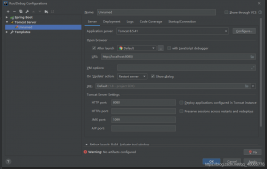在实际开发中,开发人员在编写springboot的时候通常要在本地环境测试然后再部署到production环境,这两种环境一般来讲是不同的,最主要的区别就是数据源的不同。
在应用环境中,集成在容器的抽象环境模型有两个方面:profiles和properties。只有给出的profile被激活,一组逻辑命名的bean定义才会在容器中注册。
环境变量对象角色和profiles的关系来决定哪个profiles(如果有)处于当前激活状态,哪个profiles默认被激活。
@profile
基于java类的环境配置
@profile注解可以用来标注@configuration注解的类。表示该特定环境下激活该类下的所有bean。当然也可以专门用来标注@bean,因为许多时候本地环境和production环境的区别只是数据源不同罢了。
|
1
2
3
4
5
6
7
8
9
10
11
12
13
14
15
16
17
18
19
20
21
22
|
@configurationpublic class profileconf { @bean @profile("dev") public userinfo devuserinfo() { userinfo userinfo = new userinfo(); userinfo.setid(1); userinfo.setname("dev"); return userinfo; } @bean @profile("production") public userinfo productionuserinfo() { userinfo userinfo = new userinfo(); userinfo.setid(1); userinfo.setname("production"); return userinfo; }} |
激活profile
现在我们已经更新了我们的配置,我们仍然需要说明哪个profile是激活的。如果直接注册@configuration标注的类,这将会看到一个nosuchbeandefinitionexception被抛出,因为容器找不到一个对应的环境下的bean。
|
1
2
3
4
5
6
7
|
public static void main(string[] args) { annotationconfigapplicationcontext context = new annotationconfigapplicationcontext(); context.getenvironment().setactiveprofiles("dev"); context.register(userconf.class); context.refresh(); system.out.println(context.getbean(userinfo.class));} |
默认的profile
默认配置文件表示默认启用的配置文件。
|
1
2
3
4
5
6
7
8
|
@bean@profile("default")public userinfo defaultuserinfo() { userinfo userinfo = new userinfo(); userinfo.setid(1); userinfo.setname("default"); return userinfo;} |
如果没有profile是激活状态,上面的bean将会被创建;这种方式可以被看做是对一个或者多个bean提供了一种默认的定义方式。如果启用任何的profile,那么默认的profile都不会被应用。
属性源抽象
spring 环境抽象提供了可配置的属性源层次结构的搜索操作。
|
1
2
3
4
5
6
7
8
9
10
11
12
13
14
15
16
|
public static void main(string[] args) { annotationconfigapplicationcontext context = new annotationconfigapplicationcontext();// context.getenvironment().setactiveprofiles("dev"); context.getenvironment().setactiveprofiles("dev"); context.register(profileconf.class); context.refresh(); configurableenvironment environment = context.getenvironment(); map<string, object> maps = environment.getsystemproperties(); maps.keyset().foreach(k -> system.out.println(k + "->" + maps.get(k))); system.out.println("==========================="); map<string, object> environment1 = environment.getsystemenvironment(); environment1.keyset().foreach(k -> system.out.println(k + "->" + environment1.get(k))); system.out.println(environment.containsproperty("java.vm.version")); } |
在上面的例子中可以获取environment的两个系统变量以及环境变量。
一个propertysource是对任何key-value资源的简单抽象,并且spring 的标准环境是由两个propertysource配置的,一个表示一系列的jvm 系统属性(system.getproperties()),一个表示一系列的系统环境变量(system.getenv())。
具体的说,当使用standardenvironment时,如果在运行时系统属性或者环境变量中包括foo,那么调用env.containsproperty(“java.vm.version”)方法将会返回true。
更重要的是,整个机制都是可配置的。也许你有个自定义的属性来源,你想把它集成到这个搜索里面。这也没问题,只需简单的实现和实例化自己的propertysource,并把它添加到当前环境的propertysources集合中:
|
1
2
3
|
configurableapplicationcontext ctx = new genericapplicationcontext();mutablepropertysources sources = ctx.getenvironment().getpropertysources();sources.addfirst(new mypropertysource()); |
@propertysource
上一篇文章讲到,基于java的配置很多时候会和xml混合使用。其中@import还可以导入其他java配置类,这里要说的@propertysource注解表示导入.properties文件。
|
1
2
3
4
5
6
7
8
9
10
11
12
13
14
15
16
17
18
|
@configuration@propertysource("classpath:user.properties")public class userconf { @autowired environment environment; @bean //每次调用就创建一个新的bean @scope("prototype") public userinfo userinfo() { userinfo userinfo = new userinfo(); userinfo.setid(integer.valueof(environment.getproperty("user.id"))); system.out.println(environment.getproperty("user.name")); userinfo.setname(environment.getproperty("user.name")); return userinfo; }} |
|
1
2
|
user.id=11user.name=asdasd |
任何出现在@propertysource中的资源位置占位符都会被注册在环境变量中的资源解析。
假设”user.name”已经在其中的一个资源中被注册,例如:系统属性或环境变量,占位符将会被正确的值解析。
如果没有,”default/path”将会使用默认值。如果没有默认值,而且无法解释属性,则抛出illegalargumentexception异常。
以上就是本文的全部内容,希望对大家的学习有所帮助,也希望大家多多支持服务器之家。















